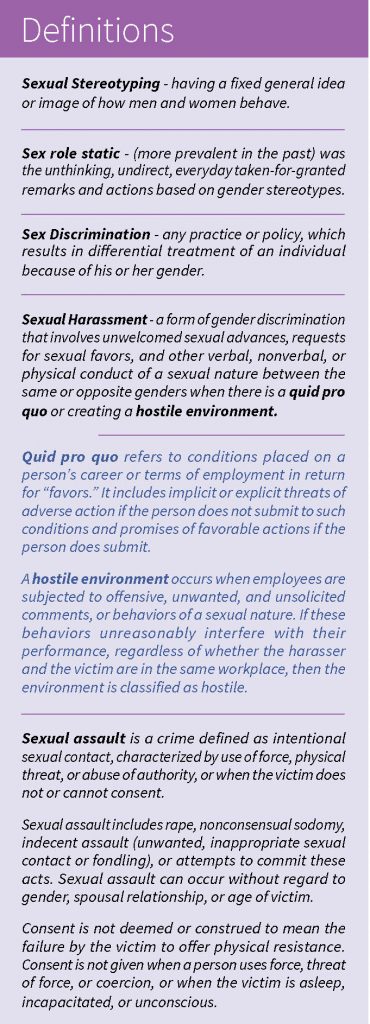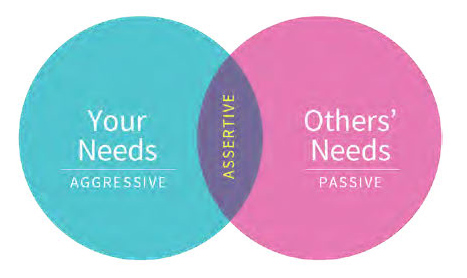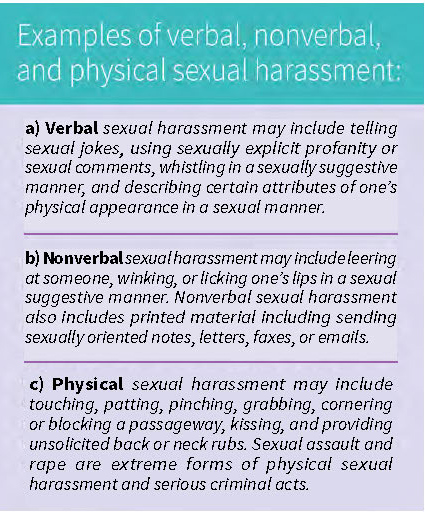Confronting the Hallway Harasser
It was my first week on my first real job. I was only 21. There was only one door to enter the building in the morning and a long hallway to walk down. At the end of the hallway was a man’s office, which you would have to pass to go either left or right. As the front door closed, the man at the end of the hall stepped out of his office and leaned against the wall. Halfway down the hall, I noticed he was staring directly at me. I looked behind in hopes that he was looking at someone else, but no one was there, which added to a sickly feeling inside. As I got closer, so did the intensity of his glance-now-turned-leer, eyeing me up and down. As I passed him, I looked down and quickly
made my way to my office.
This went on for the next couple of mornings until I decided to do something about it. On that Friday, as I walked down that same hall, I returned his stare. But my expression was more of, “What is wrong with you? Creep!” He still maintained his stare until I got right up into his face and, in the most annoyed voice I could muster, I said to him, “What’s the problem?! Something wrong with you?!” With that, he cowered back into his office.
That following Monday, when the front door opened, like the other mornings before, he stepped out. Just as he leaned against the wall, he saw it was me and quickly slipped back into his room. I was never bothered by him again. Unfortunately, it did not change his behavior toward other women.

When I first experienced this encounter, I did not have a name for it. Sexual harassment in the workplace, though it was occurring, had not yet been defined, classified, or coded. That would change that same year. Within months of starting my job in 1980, the Equal Employment Opportunity
Commission (EEOC) issued regulations defining sexual harassment and stating it was a form of sex discrimination prohibited by the Civil Rights Act of 1964. This would end Mr. Hallway Harasser’s morning pastime once and for all.
Several years later, I become a Prevention of Sexual Harassment (POSH) instructor for our organization. Part of that training was to help employees understand what Sexual Harassment was (and what it wasn’t). Definitions
were essential.
We started discussing how Sexual Stereotyping can lead to Sex Role Static and ultimately, Sex Discrimination. There was no doubt a learning curve, especially with our older generation requiring language and attitude changes toward the sexes, some deeply rooted. Terms of endearment, such as “darlin’,” “honey,” and “sweetie,” would no longer be allowed in the workplace. Restricting roles to a specific gender would now become a form of sex discrimination and not be tolerated. But the focus of the POSH training was to be able to identify, prevent, and report instances of sexual harassment and assault within the workplace. Initially, I took a simplified approach: “Don’t do or say anything to anyone that you wouldn’t say or do if your spouse, parent, child, or boy/girlfriend was standing right behind you.”
Too bad there weren’t smartphones back in my day. It sure would have been fun to have videotaped Mr. Hallway Harasser with a hashtag: #sendingtoyourwife.
Finding Your Voice
Confronting a potential incident of sexual harassment can be difficult. There are times confrontation is not possible, in which case going directly to the supervisory chain is preferable. And remember to document, document, document.
However, it is amazing how much one can handle at the lowest level, having a conversation to let people know what is and is not acceptable. When having these conversations, we tend to speak in one of three voices: Aggressive, Passive, or Assertive.
When I finally decided to confront Mr. Hallway Harasser, I used the Aggressive Voice. It is how I am personally hardwired to handle conflict situations. Although he got the message that I would not tolerate his conduct, I did not change his behavior for others. He simply labeled me with the “B” word and pursued other, less aggressive women. Those who approach these difficult situations with an aggressive voice may want to first try turning down the volume to become more effective.
Yet, the far worse approach in a sexual harassing situation is the Passive Voice, which is not only often not heard but can confuse the intended message. Not speaking up or voicing an objection can even send a message that you are either OK with it or that you will not do anything to stop it. Those who approach these difficult situations with a passive voice should consider turning up the volume. They need to find their Assertive Voice.

The Assertive Voice expresses your point of view while respecting both self and others to achieve a desired response. Had I taken a more assertive approach with Mr. Hallway Harasser, stating that his behavior was not acceptable to me or anyone else and that if it continued I would report him, I may have saved others from experiencing his sexual harassment. In fact, had I explained why it was offensive, he may have stopped on his own instead of having to be reprimanded by his supervisor, which did finally occur.
When sending a message, whether aggressively, passively, or assertively, it is important to consider what makes that message impactful. Any message is made up of three components: the Verbal, the Visual, and the Vocal. The words (the Verbal) only comprise 10 percent of the message’s impact. The nonverbal (the Visual) and the tone—how we say it (the Vocal)—make up 90 percent. That means how we carry ourselves—our walk, our posture, our dress—speaks volumes. The tone of our voice can drown out our words. The good news is, no matter how we are hardwired, whether aggressive or passive, we can learn how to adjust our volume in a certain situation to become assertive, to become effective.

We can teach employees about sexual harassment: what it is and how to report it, but where we can make the biggest impact is providing every employee with the tools and techniques to handle issues at the lowest level, in a prevention mode. Teaching how to speak in the assertive voice is worth the training bucks.
To become naturally assertive in all instances is possible but does come with a prerequisite: To be genuinely assertive, you must respect yourself and others; you must have respect for your own self-worth and dignity. FFL Speaker Joyce McCauley-Benner offers encouragement to those on the road to healing, “It is also important to recognize that experiencing trauma and abuse including assault makes having this prerequisite challenging. But know that starting the healing process, finding your voice, and reclaiming your power, leads to rediscovering your self-worth and dignity.”

Respect Yourself and Others
Recently, while participating in an exercise class at a local gym, the female instructor informed the class of her weekend plans. She and some friends were going to a male exotic dancing club, and she added that she couldn’t wait to have them dancing all up in her face. There were three men in the class, and I wondered what they thought. I waited until everyone had left and approached the instructor, assertively. I explained to her that had she been a man informing the class of plans to go to a strip club and providing his wish for close contact with the female dancers, he would have probably lost his job with the numerous reports from the women in the class. Double standards confuse the issue. If women are to be taken seriously about the issue of sexual harassment, we need to hold ourselves to the same standards we place on men. And wearing pink hats calling them a female body part is no way to advance the discussion of respecting our sexuality.
Self-Worth, Self-Respect, and the Pro-Life Feminist Message
If we are looking for the real solution, then we should be teaching everyone, starting with the very young, the concept of self-worth and self-respect. Valuing all people and considering their self-worth from the moment of conception to natural death creates an equal playing field and one where mutual respect can thrive.

Cynthia J. Wood serves as the National Operations Coordinator for Feminists for Life of America. Prior to FFL, she worked for the federal government for 35
years as an environmental scientist and trainer for numerous workshops, including Prevention of Sexual Harassment (POSH), Effective Communication, and teambuilding and leadership workshops.
Cynthia received a BS/BA in biology/English from University of North Carolina at Wilmington, completed graduate courses in environmental science from
University of Houston at Clear Lake, and received a law degree from University of Houston Law Center in 1999. She is a Bar Member of the D.C. Court of Appeals, Virginia, and Florida.
She is married and has four children.
If you would like to book Cynthia Wood to speak at your next pro-life, pro-woman event, please contact us at info@feministsforlife.org.
To read more about ReClaiming your voice, purchase The American Feminist issue here.
What else is in ReClaim?
- Introduction- Serrin M. Foster
- #MeToo: A Historical Perspective from Suffrage to Now- Kellan Monroe
- Finding My Voice After an Abusive Relationship and Coerced Abortion- Johanna E. Young
- #MenToo- Maximilian Bridges
- An Open Letter to Survivors of Intimate Partner Violence- Joyce McCauley-Benner
- How to Say No to a Boy without Hurting His Feelings- Serrin M. Foster
- Finding Your Voice to Self-Worth- Cynthia J. Wood









